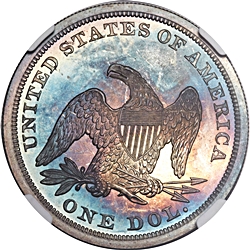 |
1863
 

|
 |
General Comments
In 1863 silver dollar mintage recovered somewhat from its bottom in 1862, but was still low, just over 27,000 coins.
This date is similar to 1862. It’s very popular with collectors due to both low mintage and its status as a Civil
War date. 1863 coins are rare in any grade. Price guides reflect the rarity of the date, pricing it accordingly.
Still the date often trades well above most price guides.
|
| |||||||||||||||||||||
1863 examples are usually well struck. Star centrals are usually sharply defined, and all other details above average. Reverses are almost always sharp. High-grade business strikes are often prooflike or semi-prooflike, but frosty examples are equally available.
1863 Die Marriages
3 die marriages have been positively identified. A single die pair was used to strike all business strikes. Neither die was used for proofs. A single obverse die was paired with two different reverses to produce two proof die marriages. Both proof reverses are transitional. Reverse PA is re-used in 1864 for two additional die marriages, Reverse PB for one. The following table summarizes the known die marriages for 1863.
Click the links below to view the details of each die marriages.
Die Marriage |
Rarity |
Obverse Die |
Reverse Die |
Estimated Survivors |
| OC-1 | R3- | 1 | A | 450 |
| OC-P1 | R4 | P1 | PA | 130 |
| OC-P2 | R4- | P1 | PB | 170 |
We note that Dave Bowers (reference 4) described two proof die marriages, but with two different obverse dies. We have observed that with motto patterns (J-345, J-346, and J-347) were struck with a different obverse die. This indicates that a second die was available. However, we’ve been unable to confirm its use to strike regular issue proofs. The reverse die used for these patterns was our Reverse 1870 PA, indicating that they were probably struck in the 1870 timeframe.
1863 Business Strike Emission Sequence
With only a single business strike die marriage the emission sequence is simple.
Emission Order |
Die Marriage |
Comments |
| 1 | OC-1 |
1863 Proof Emission Sequence
We believe that progressing die polish on Obverse P1 indicates that the sequence listed below is correct.
However, the differences are minute, and open to interpretation. Suffice it to say that we made our best educated guess.
Emission Order |
Die Marriage |
Comments |
| 1 | OC-P1 | |
| 2 | OC-P2 | Die polish slightly reduced the unfinished area under the chin |
1863 Quick Finder Chart
Attribution of 1863 die marriages is relatively easy. Neither the obverse nor reverse dies display major markers,
but the obverse date positions are notably different on the two known obverse dies. The only challenge is
differentiating the two known proof reverse dies. Fortunately, proofs are usually relatively high grades,
making the minor diagnostics visible. The following table lists the keys for identifying each variety:
Die Marriage |
Obv Die |
Rev Die |
Right |
Keys |
| OC-1 | 1 | A | C | Obverse: 1 is VSH. Reverse: A light die line joins the lower two leaves. |
| OC-P1 | P1 | PA | LE | Obverse: 1 is L. Reverse: No extensions of the vertical shield lines. The lowest horizontal shield line crosses the shield border, barely poking into the wing feathers. |
| OC-P2 | P1 | PB | LE | Obverse: 1 is L. Reverse: Vertical shield line 1-3 extends to horizontal line 5. The lowest horizontal shield line crosses the shield border, but doesn’t poke into the wing feathers, and the extension is lighter than that of Reverse PA. |
| Photo credits:
Obverse and reverse full photos: 1863 NGC PR69, finest known, ex. Kaufman, from the Heritage archives. |
